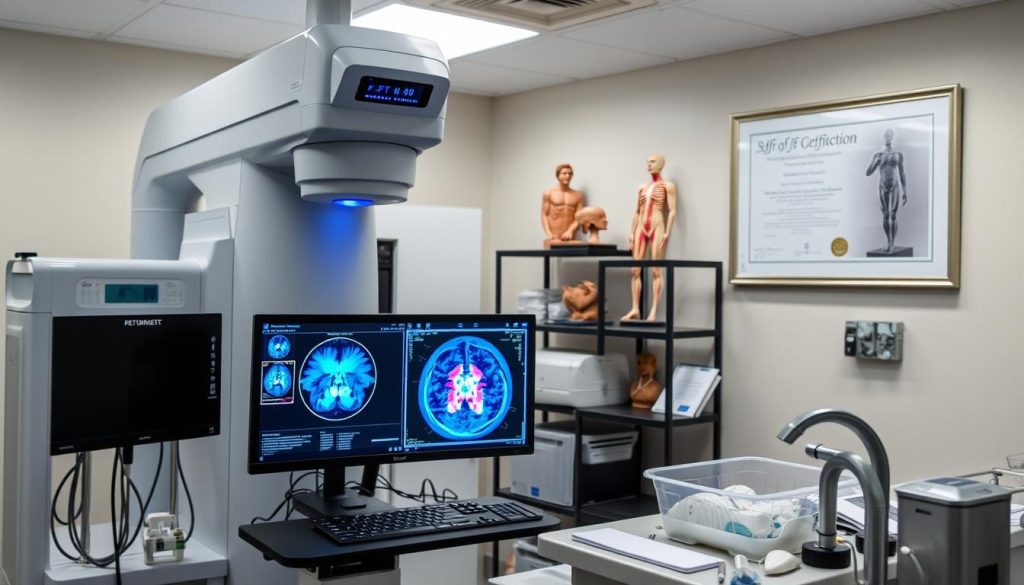Starting a career in nuclear medicine imaging? The PET (Positron Emission Tomography Technologist Certification) Test is key. This guide covers everything you need to know about the PET certification exam. It helps you prepare and move forward in this healthcare field.

Positron Emission Tomography (PET) is a key imaging method in nuclear medicine. PET technologists use this advanced tech to create detailed images of the body’s inner workings. Getting certified as a PET technologist shows you have the skills and knowledge needed for this field.
The PET technologist certification tests your skills in using PET imaging tools, working with radiopharmaceuticals, and keeping patients safe. It proves you know the basics of PET imaging, like radiation safety and patient care.
Having a PET technologist certification is highly respected in nuclear medicine and radiology. It shows you’re dedicated to your career and skilled in patient care. Certified PET technologists are sought after for their ability to use complex equipment safely and accurately.
| Key Benefits of PET Technologist Certification | Description |
|---|---|
| Enhanced Job Opportunities | Many employers in the nuclear medicine and radiology fields prefer or require PET technologist certification, as it demonstrates a technologist’s expertise and commitment to the profession. |
| Improved Patient Care | Certified PET technologists are trained to handle radiopharmaceuticals, operate imaging equipment, and provide high-quality patient care, ensuring accurate and reliable diagnostic results. |
| Professional Development | Earning the PET technologist certification opens up opportunities for career advancement and demonstrates a technologist’s dedication to continuous learning and improvement. |
Getting the PET technologist certification shows you’re a pro in nuclear medicine imaging. It highlights your technical and professional skills.
Those wanting to be pet technologists must first meet certain requirements. They need to pass the certification exam given by the Nuclear Medicine Technology Certification Board (NMTCB). This makes sure they have the right knowledge and skills in nuclear medicine, radiology, and patient care.
To qualify for the PET (Positron Emission Tomography Technologist Certification) Test, you must have a current ARRT (American Registry of Radiologic Technologists) certification. This can be in radiography, nuclear medicine, or radiation therapy. You also need to have finished a formal education in nuclear medicine technology or a related field. This education must be accredited by the Joint Review Committee on Educational Programs in Nuclear Medicine Technology (JRCNMT).
| Eligibility Criteria | Requirement |
|---|---|
| Educational Background | Completion of a JRCNMT-accredited nuclear medicine technology program or a related field (e.g., radiologic technology) |
| Certification | Current ARRT certification in radiography, nuclear medicine, or radiation therapy |
| Experience | Minimum of 1 year of full-time clinical experience in nuclear medicine or emission tomography |
Candidates also need at least one year of full-time clinical experience. This experience must be in nuclear medicine or emission tomography. It should include working with radiopharmaceuticals, radiation safety, and patient care. This hands-on experience is crucial for imaging technologists to provide top-notch care to patients.
By fulfilling these strict prerequisites, aspiring PET technologists show their dedication to the field of nuclear medicine. They also prove they are ready to do well in the certification exam.
To do well on the PET exam, it’s key to know what it covers. The test includes topics like nuclear medicine, radiopharmaceuticals, and safety. It also tests your knowledge of patient care and anatomy.
The PET exam has 150 multiple-choice questions. You have 3 hours to finish. It checks if you know nuclear medicine and how to use it in real situations.
There are many ways to get ready for the PET exam. You can use textbooks, online guides, and practice tests. Also, talking to other PET technologists and using resources from the Nuclear Medicine Technology Certification Board (NMTCB) can help.